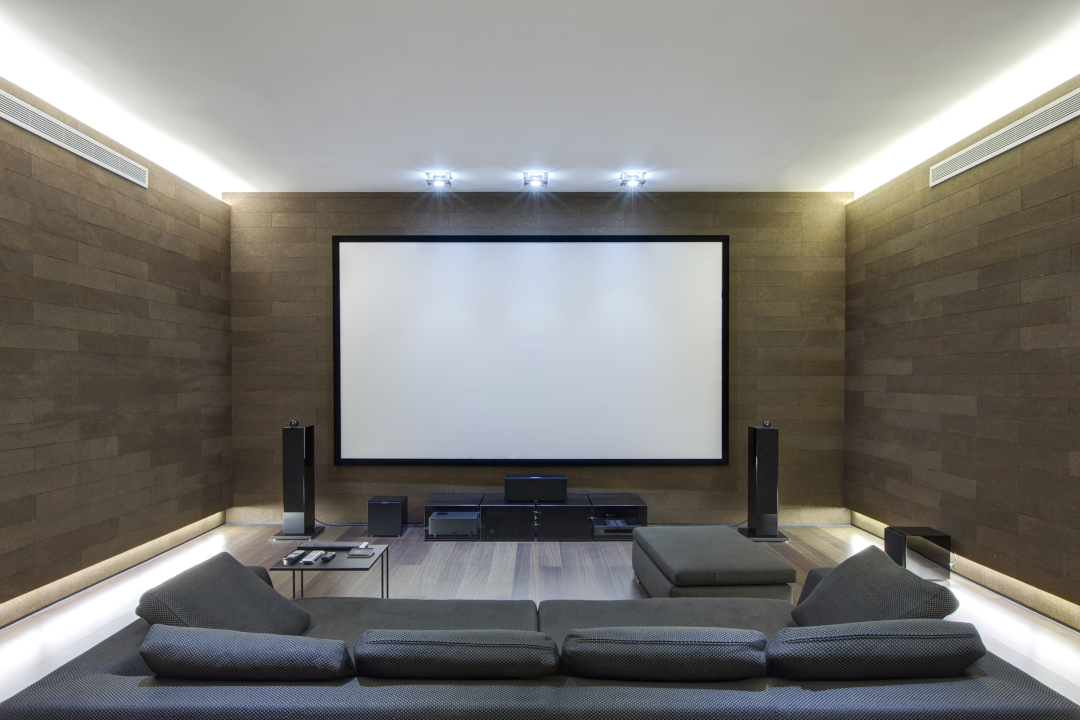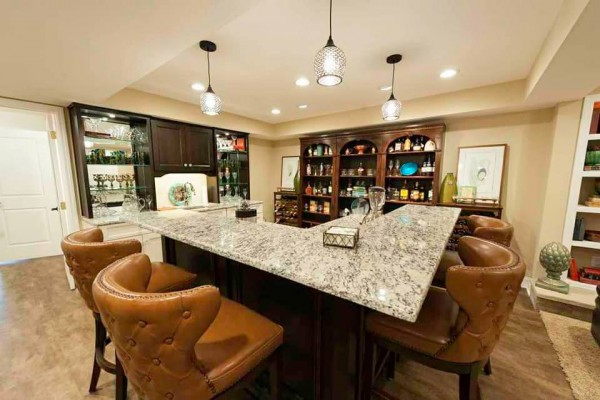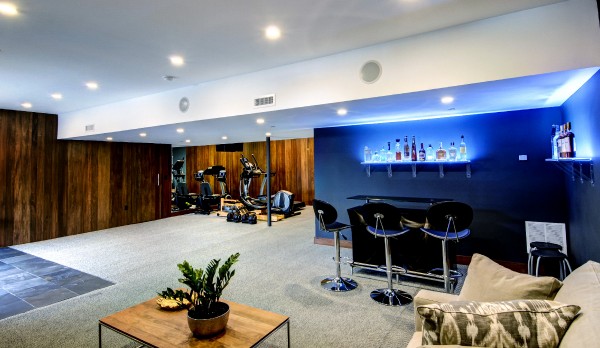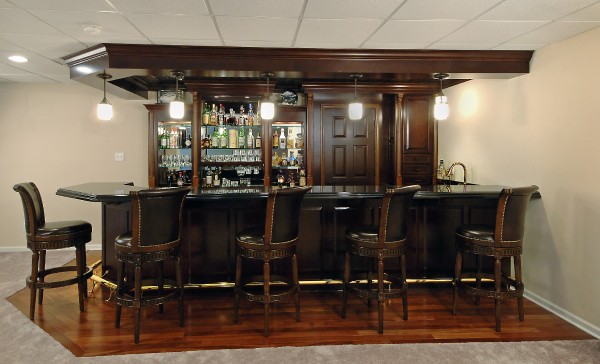Untapped Potential

Even the closest of families sometimes need a little bit of time apart from one another. Whether it's young kids craving a dedicated room to play in, teenagers looking to hang out with friends, or adults requiring a home office to work in peace and quiet, finding the space can be difficult. More and more homeowners are looking downstairs to solve the dilemma.
 Finishing a basement to create extra living space has always been popular, but since the pandemic struck and families were stuck at home more often, this type of remodeling project has become even more in demand. In fact, local contractors have seen a significant rise in requests over the past 20 months.
Finishing a basement to create extra living space has always been popular, but since the pandemic struck and families were stuck at home more often, this type of remodeling project has become even more in demand. In fact, local contractors have seen a significant rise in requests over the past 20 months.
"Once the kitchen and baths are done, the basement is always next on the list, especially for a family," says Dan Dilworth of Dilworth's Custom Design. "It makes sense to finish off the basement and make it another living space, even if you only use it while the kids are at home."
Dennis Gehman of Gehman Design Remodeling starts a basement renovation the same way he does every project: by having an extensive conversation with the clients to discover exactly what they're looking to accomplish so he and his team can come up with the appropriate plan.
"Initially you have to ask the question, 'What do you want to use this space for?'" he says. "If it's a playroom for the kids, then all we need is drywall on the walls, a few lights in the ceiling, carpet on the floor and then we can paint the room and it's ready. But if it's a home office area, a home theater, a workout area or a bar, [it gets more complicated]. We've done them where it's basically a whole other house with a kitchen, a laundry, a bedroom, all those types of things."
No matter what the space is going to be used for, there are important precautions that must me taken even before the design is considered or construction can begin. House & Home spoke to several area professionals to learn more about these steps along with design trends and creative solutions to common issues.
Starting the process
After the decision has been made to finish the basement and the contractor has been hired, one of the very first concerns is addressing any mildew or moisture issues. Hurricane Ida recently served as a reminder that serious storms have become more frequent in this area, and water damage can have major implications regarding such an expensive investment.
According to Todd Prosan of '58 Foundations, groundwater problems are more prevalent in older homes, but leaks can happen anywhere.
"Through our 63 years in business, we've worked with many builders and had to have fixed thousands of leaky basements in homes under a year old," he says.
"The best time to waterproof the basement is before finishing it—even if it's precautionary. There are less expensive ways to prepare a basement ahead of finishing it that can be added to later at a lesser cost if a water problem presents itself. If there is a water problem, identifying the source of the problem and the solution comes from our years of experience, training, plus working with the homeowner—asking lots of questions and together creating a custom solution that fits what they are trying to accomplish in their home."
Kevin McCormack of McCormack Construction has completed many basement remodels and says the winter is a particularly busy time for such a project. Assessing any moisture issues is always one of his first priorities.
 "You look around at the basement and see if there's been a history of seepage of water or direct water coming in through the wall," he says. "A lot of times that can be corrected from the exterior because the grade is sloping to the foundation and when it rains the water is collecting there. So you can change the grade by lifting it up with some soil and pitching it away from the house. That's the simple way to do it.
"You look around at the basement and see if there's been a history of seepage of water or direct water coming in through the wall," he says. "A lot of times that can be corrected from the exterior because the grade is sloping to the foundation and when it rains the water is collecting there. So you can change the grade by lifting it up with some soil and pitching it away from the house. That's the simple way to do it.
"It also might be a combination of doing that and waterproofing the basement by putting a French drain in around the perimeter before you do the remodel. If there's any sign that water has been there ... it's silly to put in a remodel without putting a drain around the building and a sump pump. That would be a major mistake. You have to put a good plan together."
In addition to waterproofing, it also makes sense to examine the foundation before the renovations are started.
"While we're asking questions of the homeowner to better understand the home, we do a thorough interior and exterior inspection of the entire foundation," Prosan says. "Besides waterproofing, we provide foundation settlement and wall solutions. Many hairline cracks in poured concrete floors and vertical cracks in walls occur during the concrete curing phase when the house is first built. As long as these cracks aren't leaking or getting wider, they are probably fine to leave alone. If cracks leak, we can seal them. If they are expanding, are horizontal on the wall, or stair-step shaped in concrete block walls, this can be a sign of a potential foundation settling problem or external pressure problem on the walls. For either of these issues, structural supports may be necessary."
Other important steps
Once the moisture issues have been resolved, that doesn't mean the homeowner is in the clear just yet. There are other significant conversations to be had.
"The next big thing to think about is egress, especially if you're putting a bedroom down there," Dilworth says. "Some townships want an egress no matter what, in any enclosed space. That's basically a window of a certain minimal size or a door to get outside in case of emergency."
A Bilco door is a common method for egress, but there are some houses where adding a door or window is not possible because of the way the structure is situated. In those cases, Dilworth adds, the client may have to adjust plans for the space.
HVAC is another item to be checked off the list, but according to Gehman, that's not always as easy as some homeowners expect.
"Most people say they'll just tie into the existing HVAC, but generally speaking we are unable to do that because the existing unit was sized for a certain square feet of living space," he explains. "Let's say it's a two-story house and it has one HVAC unit; if we finish the whole basement we're basically adding 50% more space, and the one unit is not going to be enough."
Reuben Stoltzfus of EWBN believes this is where the expertise of an experienced contractor comes into play. "One of the most important aspects with your HVAC is knowing the system can handle the space," he says. "If it's too small there will be temperature issues and if it's too large, it is money wasted. Understanding and having familiarity with township regulations is key, especially when it comes to the timing of the project."
McCormack points out that because most basements usually don't get too cold or too hot, there are multiple options to consider. Air conditioning might not even be necessary.
"The good thing about a basement is most of it is in the ground, so you're already insulated by the earth," he says. "In an attic, forget it, it's blazing hot up there. But the basement stays kind of cool so you don't really need air conditioning, and you can use other sources of heat without spending a lot of money. Not that I recommend electric heat, but you might only need a couple of sections which is very simple and you can put it on its own thermostat. Or you can do another boiler or a heat pump that does heating and air conditioning."
Getting creative
Many basements have odd space configurations or elements that may not be a factor in other rooms in the house. Designers often take pleasure in using their creative side to come up with interesting solutions.
"The CAD [computer-aided design] program that we use is designed for kitchens and baths, but we can also use it for any room in the house, including the basement," Dilworth says. "We can put the walls anywhere we want: around support poles, around sump pumps, around strange structural configurations with the exterior cinderblock walls and stuff like that. ... All of that can [be resolved] through the CAD system and you can draw it up as detailed as you want. ... There are limitations of course, but at the same time, in the digital age you can draw just about anything."
Certain basements come with their fair share of challenges, but these idiosyncrasies can also make the space unique and something that stands out to friends and family.
"Sometimes, odd spaces can become a conversation piece," Stoltzfus says. "For example, last fall we did one basement remodel where the space under the stairs was converted to a kids' cave, which was an instant favorite with our clients' children. Other times, we have used custom cabinetry to fit the space and everyone could always use extra storage space. When creativity is needed, that is when projects become more fun, not just for me, but also the crew."
McCormack and Gehman have both been part of projects where lally columns were hidden in walls, turned into decorative aspects or even relocated.
 "Sometimes there's a space that makes sense to put the big-screen TV and the seating, but you've got one or two columns in the way," Gehman says. "Most of the time people just work with them, but sometimes it makes sense and they're willing to spend the money for us to do some structural engineering to figure out a way to get those columns out of there. People ask us, 'Can you do that?' Well, bridges are made of beams and typically there's not a column coming down in the middle of it, so it can be done. But it's time and money and unfortunately both of those are limited resources."
"Sometimes there's a space that makes sense to put the big-screen TV and the seating, but you've got one or two columns in the way," Gehman says. "Most of the time people just work with them, but sometimes it makes sense and they're willing to spend the money for us to do some structural engineering to figure out a way to get those columns out of there. People ask us, 'Can you do that?' Well, bridges are made of beams and typically there's not a column coming down in the middle of it, so it can be done. But it's time and money and unfortunately both of those are limited resources."
The end result
Like any renovation project, a finished basement has obstacles to overcome, but when all is said and done most homeowners are thrilled with the extra living space they have added to their homes.
"One of the things we'll hear is, 'I'm sorry I didn't do this sooner. I don't know why I waited so long, I could have used this space even more when the kids were younger,'" McCormack says. "Or clients will say, 'I'm glad I have this space now away from family members where I can concentrate on my work more or have my man cave.' Everybody has a different angle and everybody is appreciative of our work because we're very detail oriented."
Stoltzfus and his team are just as pleased as the clients when they can deliver on their promises for the space.
"We get a lot of wows," he says. "No one ever anticipates the final look being as great at it is. It is the most joyful reaction and it brings our entire team so much satisfaction knowing the customer is a happy one."
RESOURCES
'58 Foundations
Serving the tri-state region
(302) 337-5092 (Del.)
(856) 367-5154 (N.J.)
(610) 822-9849 (Pa.)
58Foundations.com
Dilworth's Custom Design
Phoenixville, Pa.
(610) 917-9119
DilworthsCustomDesign.com
EWBN
New Holland, Pa.
(717) 355-0741
EWBN.net
Gehman Design Remodeling
Harleysville, Pa.
(215) 513-0300
GehmanRemodeling.com
McCormack Construction
Madison, N.J.
(973) 360-1900
McCormackContractingInc.com
Published (and copyrighted) in House & Home, Volume 22, Issue 2 (November/December 2021).
For more info on House & Home magazine, click here.
To subscribe to House & Home magazine, click here.
To advertise in House & Home magazine, call 610-272-3120.
